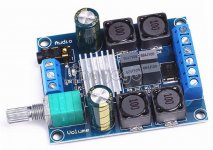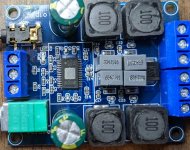I happened to see this board mentioned in another thread. It has a link to AliExpress, which shows a picture with product name:
2x50W TPA3116D2 carte amplificateur numerique stereo double canal DC 4.5 27V classe D | AliExpress
So this board is called XY-502. Mine could be a clone because it does not have the name printed on the board.
2x50W TPA3116D2 carte amplificateur numerique stereo double canal DC 4.5 27V classe D | AliExpress
So this board is called XY-502. Mine could be a clone because it does not have the name printed on the board.
I have that board. It is a slightly cheaper replica of a board with the same layout. I changed the two rail decoupling capacitors and nothing more. The price you have found seems a bit high. I paid around 4.5$ including sending costs.
It is one of the cheapest TPA3116 boards but with a decent performance.
It is one of the cheapest TPA3116 boards but with a decent performance.
Thanks. I did find some cheaper ones online as well. I use these for playing around with minor modding. Upon closer inspection, the cheaper version I found might be inferior, judging from the reprinted caps near outputs.
Can you tell me some more about the changes you made to decoupling capacitors and why (Are they C3 & C4)? I did the typical removal of R4 to drop gain to 20db.
Can you tell me some more about the changes you made to decoupling capacitors and why (Are they C3 & C4)? I did the typical removal of R4 to drop gain to 20db.
Attachments
Last edited:
My output filter capacitors (the gray ones) look the same. Why they have been re-printed to the same value I cannot say. Sometimes they use components with small defects (printing) in cheap production. I wouldn't worry as the amplifier seems to play well. It is after all a cheap board.
The rail decoupling capacitors are the relatively big green/yellow electrolytic capacitors. I had some low-ESR Nichicon replacements I know are reliable.
Your amplifier seems configured for a gain of 32dB. If you remove R4 ("01D") you should get 20dB gain.
The rest is OK. You do not have space for foil input capacitors anyway. Do not invest to much in "pimping" a cheap board.
The rail decoupling capacitors are the relatively big green/yellow electrolytic capacitors. I had some low-ESR Nichicon replacements I know are reliable.
Your amplifier seems configured for a gain of 32dB. If you remove R4 ("01D") you should get 20dB gain.
The rest is OK. You do not have space for foil input capacitors anyway. Do not invest to much in "pimping" a cheap board.
I have a similar board here, works well after replacing the power supply capacitors with some solid polymer ones, and applying snubber circuits to the bootstrap capacitors, as per the TI evaluation module schematic.
Mine was advertised to have tpa3116, and it came with chips marked tpa3118, even has a heat sink on top like the tpa3116.
Mine was advertised to have tpa3116, and it came with chips marked tpa3118, even has a heat sink on top like the tpa3116.
I have a similar board here, works well after replacing the power supply capacitors with some solid polymer ones, and applying snubber circuits to the bootstrap capacitors, as per the TI evaluation module schematic.
I have a few of these boards. I probably will give the above a try some time down the road.
I've heard of some class-d boards built with incorrect output inductors, which badly affected the frequency response. If in doubt, compare the parts on the board with the data sheet. "Silicon Chip" magazine, May 2019, p38 describes an amp that had 55 uH inductors instead of 10 uH, causing rolled-off treble.
I have a few of these boards. I probably will give the above a try some time down the road.
The one I just received didn’t take well to a simple capacitor replacement, so if you decide to change anything, I would recommend only adding onto any existing leads. Don’t know why, maybe the solder migrates between the layers of the boards or something during resoldering.
I think I’ve bought four of those or similar ones, and only one is functional after replacing parts.
You’ve been warned.
The one I just received didn’t take well to a simple capacitor replacement, so if you decide to change anything, I would recommend only adding onto any existing leads. Don’t know why, maybe the solder migrates between the layers of the boards or something during resoldering.
I think I’ve bought four of those or similar ones, and only one is functional after replacing parts.
You’ve been warned.
Thanks for the heads up.
I just got yet another, and this time I purchased through Amazon. The extra couple bucks to get something in a couple days was worth it to me anyways.
It’s now playing nicely with some solid polymer capacitors added onto the leads of the ones that came installed on the board.
It’s now playing nicely with some solid polymer capacitors added onto the leads of the ones that came installed on the board.
There are even worse Chinese boards.
https://aliexpress.ru/item/32845742...38a0234d6783d97243f8560989&sku_id=65165778331
https://aliexpress.ru/item/32845742...38a0234d6783d97243f8560989&sku_id=65165778331
You need to use the correct circuitry. Balanced input, greatly improves sound quality.
[url=https://postimg.cc/hQBypNkc] [/URL]
[/URL]
[url=https://postimg.cc/hQBypNkc]
 [/URL]
[/URL]- Home
- Amplifiers
- Class D
- Help Identify This TPA3116 Board


